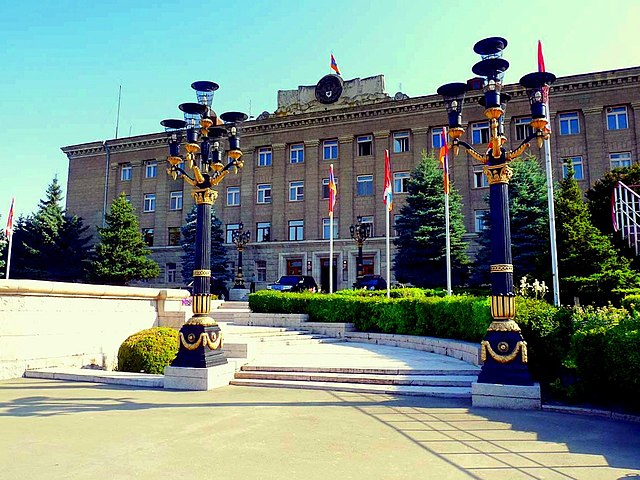Stepanakert or Khankendi is a ghost city in the Nagorno-Karabakh region of Azerbaijan. The city was under the control and the capital city of the breakaway Republic of Artsakh prior to the 2023 Azerbaijani offensive in the region. The city is located in a valley on the eastern slopes of the Karabakh mountain range, on the left bank of the Qarqarçay (Karkar) river.
From top left: Holy Mother of God Cathedral Renaissance Square • Downtown Stepanakert Stepanakert Airport • Stepanakert skyline Park Hotel Artsakh • We Are Our Mountains Artsakh University • Stepanakert Memorial
The Presidential Palace, formerly the building of the Supreme Soviet of the Nagorno-Karabakh Autonomous Oblast.
Renaissance Square.
Freedom Fighters' Boulevard in central Stepanakert.
Nagorno-Karabakh is a region in Azerbaijan, covering the southeastern stretch of the Lesser Caucasus mountain range. Part of the greater region of Karabakh, it spans the area between Lower Karabakh and Syunik. Its terrain mostly consists of mountains and forestland.
June 2001 NASA photograph of the snow-covered Lesser Caucasus in the south of the Greater Caucasus. Around the year 1800, the Karabakh Khanate was based in the southeast corner of the Lesser Caucasus. It extended east into the lowlands, hence the name Nagorno- or "Highland-" Karabagh for the western part.
The Amaras Monastery, founded in the 4th century by St Gregory the Illuminator. In the 5th century, Mesrop Mashtots, inventor of the Armenian alphabet, established at Amaras the first school to use his script.
The monastery at Gandzasar was commissioned by the House of Khachen and completed in 1238
The Shusha fortress, built by the Karabakh Khanate ruler Panah Ali Khan in the 18th century








